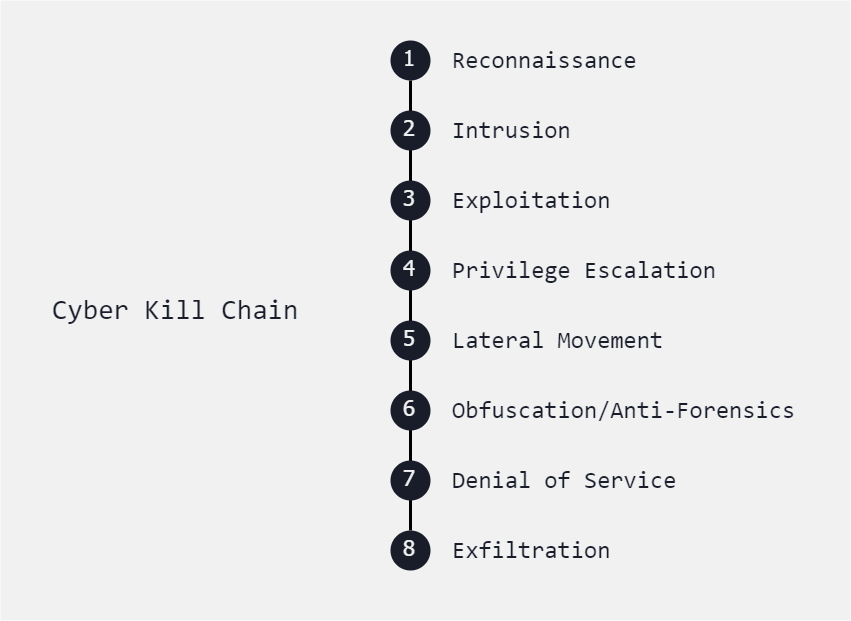Attack Frameworks
Each of the models below have their own benefits and drawbacks. They can be used individually or combined.
Cyber Kill Chain
A model developed that describes the stages by which a threat actor progresses a network intrusion.
These are the generic stages of Cyber Kill Chain Analysis.

Below is another variation of the Cyber Kill Chain which focuses on a detailed range of stages.

Reconnaissance
- Gathering information about the target, such as identifying vulnerabilities and system configurations.
- Example:
- Conducting port scans
- network mapping
- OS fingerprinting to identify potential entry points into the target network.
Intrusion
- Gaining unauthorized access to the target system or network.
- Often done through exploitation of vulnerabilities.
- Example:
- Exploiting a known software vulnerability to gain access to a web server
- Exploiting weak credentials to log in to a database.
Exploitation
- Utilizing identified vulnerabilities to compromise the target system or gain control.
- Example:
- Exploiting a buffer overflow vulnerability in a web application
- Execute arbitrary code or deploying malware through a phishing email.
Privilege Escalation
- Elevating privileges to gain deeper access and control over the compromised system or network.
- Example:
- Exploiting a misconfigured service to gain root access on a Linux server
- Exploiting a Windows privilege escalation vulnerability to gain administrative privileges.
Lateral Movement
- Moving laterally within the network to expand access and compromise additional systems or resources.
- Example:
- Using compromised credentials to pivot from one system to another within the network
- Exploiting trust relationships between systems to gain access to sensitive data.
Obfuscation/Anti-forensics
- Concealing malicious activities and evade detection by security tools and forensic analysis.
- Example:
- Encrypting malware payloads to evade antivirus detection
- Using steganography to hide malicious code within image files
Denial of Service
- Disrupting the availability of services or resources to legitimate users.
- Achieved by overwhelming systems with excessive traffic or resource requests.
- Example:
- Launching a distributed denial-of-service (DDoS) attack against a web server.
- Flooding a network with malformed packets to degrade performance.
- This makes it unavailable to legitimate users
Exfiltration
- Stealing sensitive data from the compromised system to external servers controlled by attackers.
- Example:
- Extracting customer credit card information from a compromised database
- Then transferring it to a remote server under the attacker’s control
- Exfiltrating proprietary company documents via encrypted communication channels.
MITRE ATT&CK Framework
A knowledge base maintained by the MITRE Corporation for listing and explaining specific adversary tactics, techniques, and common knowledge (ATT&CK) or procedures (attack.mitre.org).
- The pre-ATT&CK tactics matrix aligns to the reconnaissance and weaponization phases of the kill chain.
- Used for post-compromise analysis to identify attacker techniques:
- What was done?
- How was it done?
Mitigation techniques:
- Modify existing firewall or IDS/IPS alert rules
- Deploy honeypot traps
Diamond Model of Intrusion Analysis
A framework for analyzing cybersecurity incidents and intrusions by exploring the relationships between four core features:
- Adversary
- Infrastructure
- Victim
- Capability
It shows how malicious actors use exploit capabilities over an infrastructure againsts victims.
- Use data from honeypots